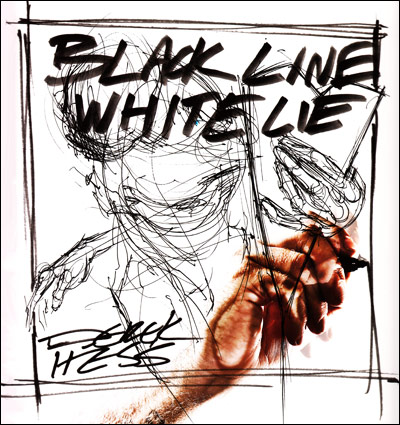
by Stephen Slaybaugh
It doesn’t take much digging to recognize that there’s been a long lineage between the rock and art worlds. From R. Crumb’s artwork for Janis Joplin’s Big Brother & the Holding Company to Andy Warhol’s iconic Velvet Underground cover to Kenny Scharf’s contribution to The B-52s’ Bouncing Off the Satellites to Frank Kozik’s and Art Chantry’s designs in the ’90s, there have been countless examples of the two spheres collaborating. But then it seems only logical that the visual and the audial would meet as they’ve no doubt inspired each other.
A couple bundles of such related materials have come across the Agit Reader desk as of late. The first is Black Line White Lie (Strhess), a compendium of more than 275 pen and ink drawings by Cleveland-based artist Derek Hess. Hess, who studied print-making at the Cleveland Institute of Art, began his artistic career in the early ’90s by doing posters for the shows he was booking at the Euclid Tavern. In a natural extension of such work, he went on to do album covers for artists ranging from Season to Risk to RL Burnside. These days, his work occupies institutions as varied as the Rock & Roll Hall of Fame and the Louvre, and Hess has moved on to showing in galleries rather than in rock clubs.
Black Line White Lie encompasses the entirety of Hess’ career, with art that ended up on flyers and posters as well as in more “serious” pieces. (There is also a final chapter comprised of photographs of the tattoos people have gotten of Hess’ work.) Organized both by subject matter (bones, animals) and thematically (good, aggression), the book shows the reoccurring motifs in Hess’ work and how such visuals have manifested themselves in different ways as he has evolved as an artist over the years. With an anatomical quality and bold lines, Hess’ art has always been instantly recognizable for its inherent artistry. It is not surprising that the many angels and devils that have occupied his work have transcended their onetime roles as rock & roll symbols. Particularly engaging are some his later works where Hess’ lines have grown denser and which are sometimes more suggestive than exact. My one complaint with the volume is its lack of information, as at least knowing a date for each piece would help give some context. Otherwise, this is a great encapsulation of a deserving artist.

Somewhere else on the spectrum is Nix Comics, a comic series published by former Columbus record store clerk Ken Eppstein that is now on its fourth issue. Much of the subject matter is music-related, with reoccurring characters like a vampire-hunting, bandleading priest and a series of unbelievable but true tales from music lore called Did It Really Happen? Additionally, many of the illustrators working on Nix Comics are musicians in their other lives, including the Great Plains’ Matt Wyatt, Donovan Roth (ex-Bob City, ex-Grafton, currently of Sick Thrills), and Columbus saxman Bob Ray Starker.
Thus far, the comics Nix has churned out have been highly enjoyable. When Eppstein isn’t writing about the various guises the devil may take (a music journalist, Brian Jones), there is usually at least a few delves into the classic horror realm of vampires, werewolves and zombies. Plus, the illustrations of such standouts as Glen Ostander and Ryan Brinkerhoff are really top-notch and transcend the limitations of the DIY operation. More than anything Nix’s mix of goofball aesthetics and artistic talent makes for an engaging read energized with a fitting punk spirit.
The Gories Live Review
Jeff Mangum and Califone Live Reviews
Scud Mountain Boys Live Review
Kill All Redneck Pricks: A Documentary Film About a Band Called Karp
Death of Samantha Live Review
Kathryn Calder and Mark Eitzel Live Review
The Ballad of Mott the Hoople
I Want My MTV: The Uncensored Story of the Music Video Revolution
Lindsey Buckingham Live Review
Scratch Acid Live Review
Def Jam Recordings: The First 25 Years of the Last Great Record Label
Beats, Rhymes & Life: The Travels of A Tribe Called Quest
Put the Needle on the Record
The Karaoke Singer's Guide to Self-Defense
